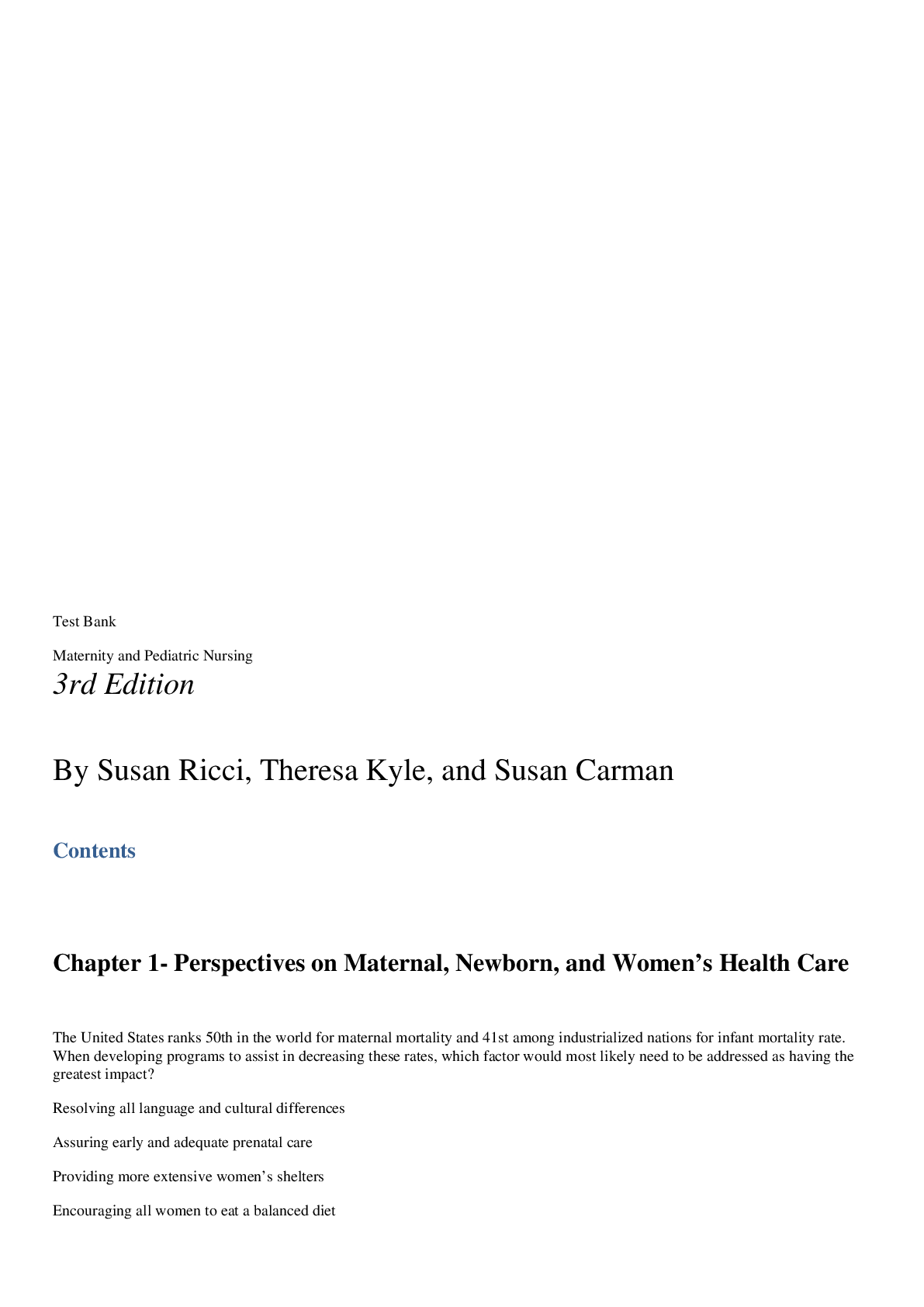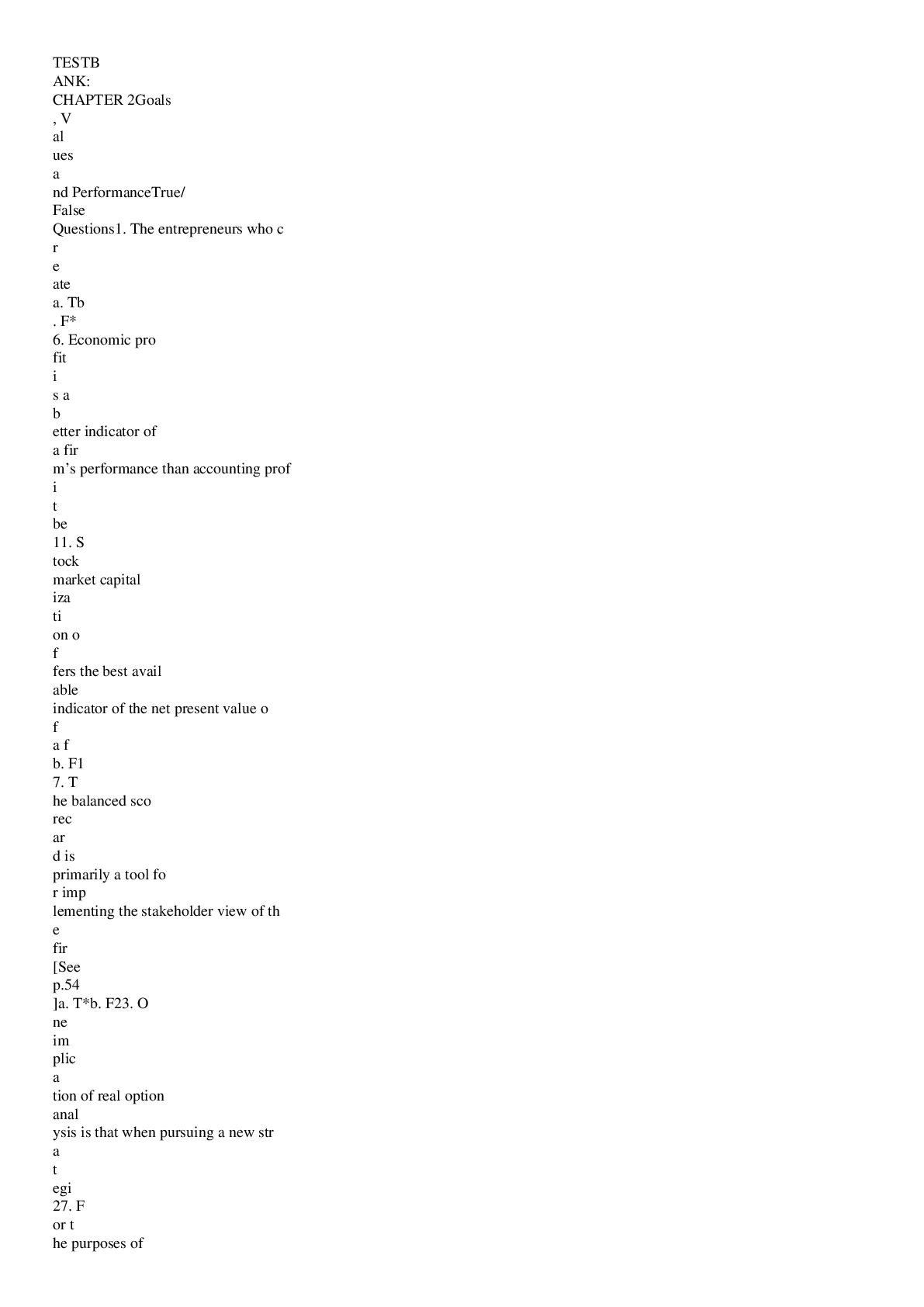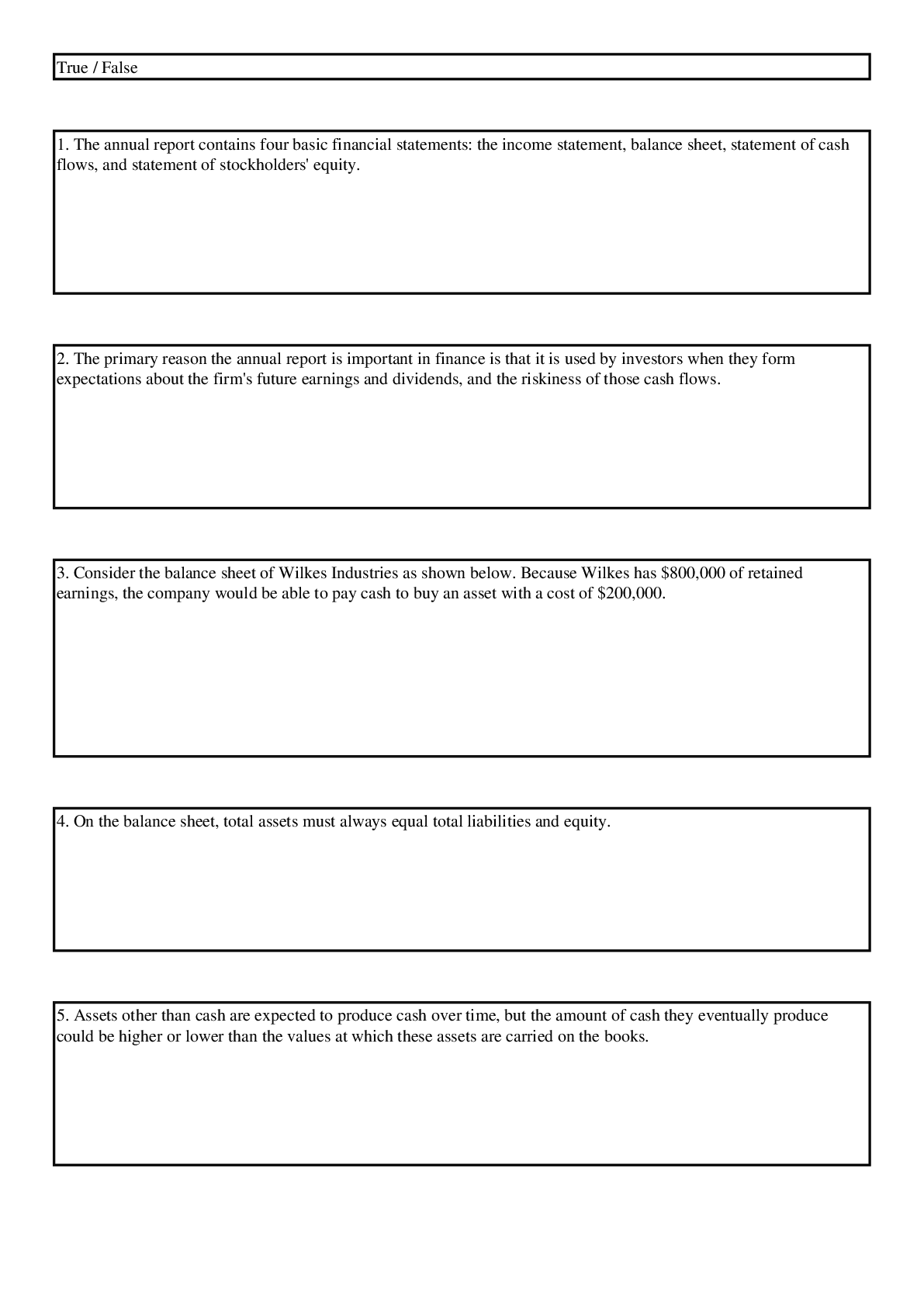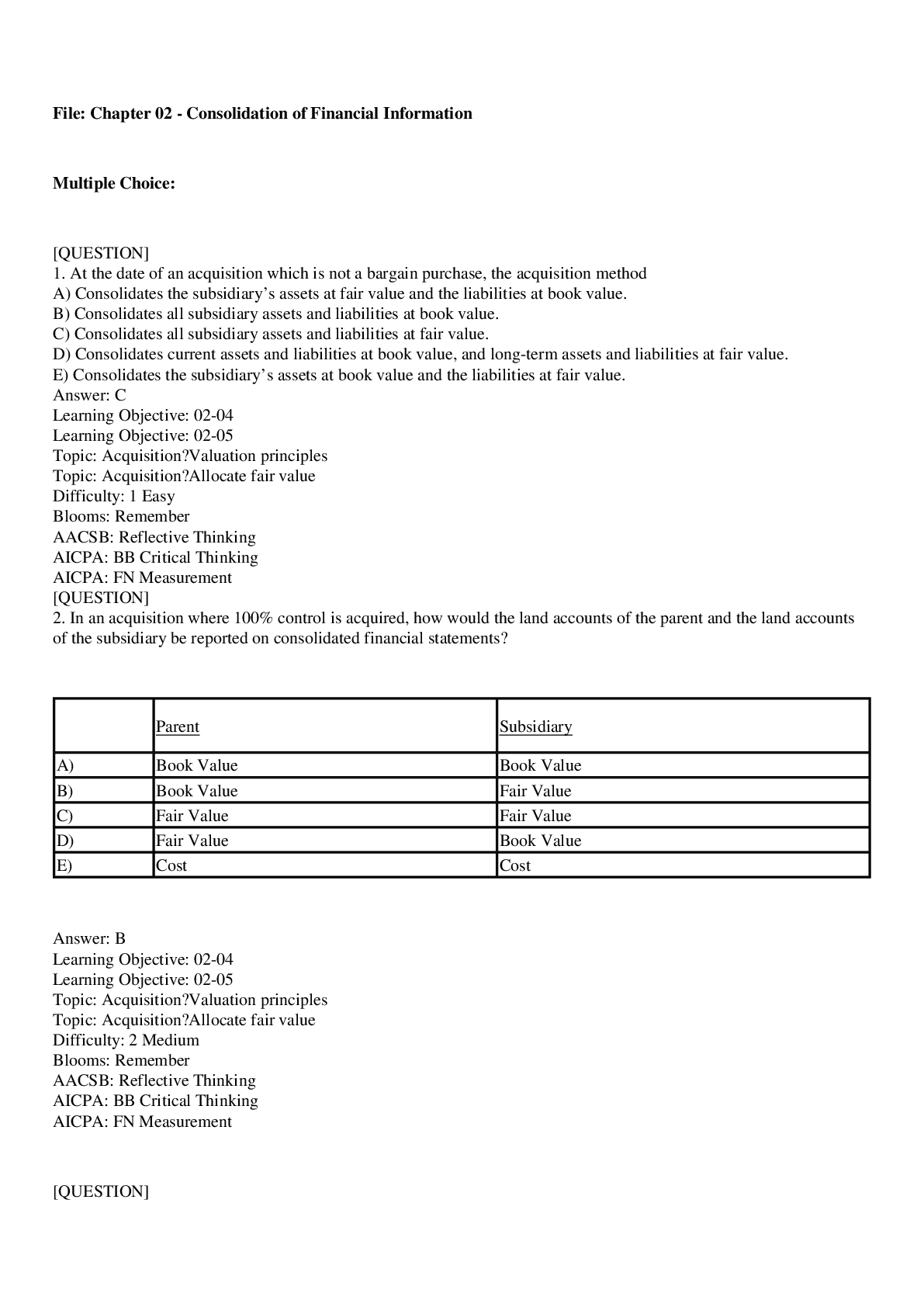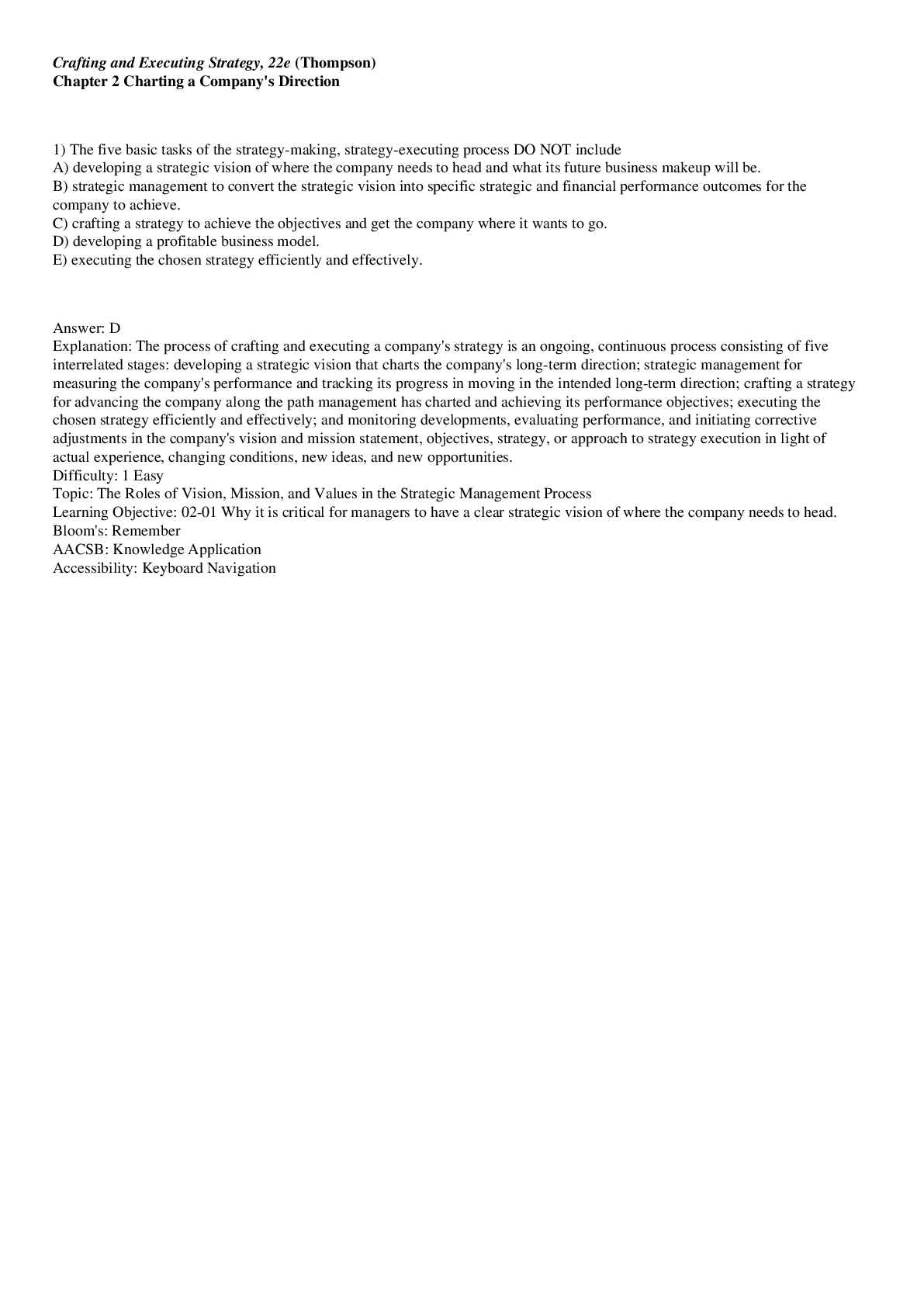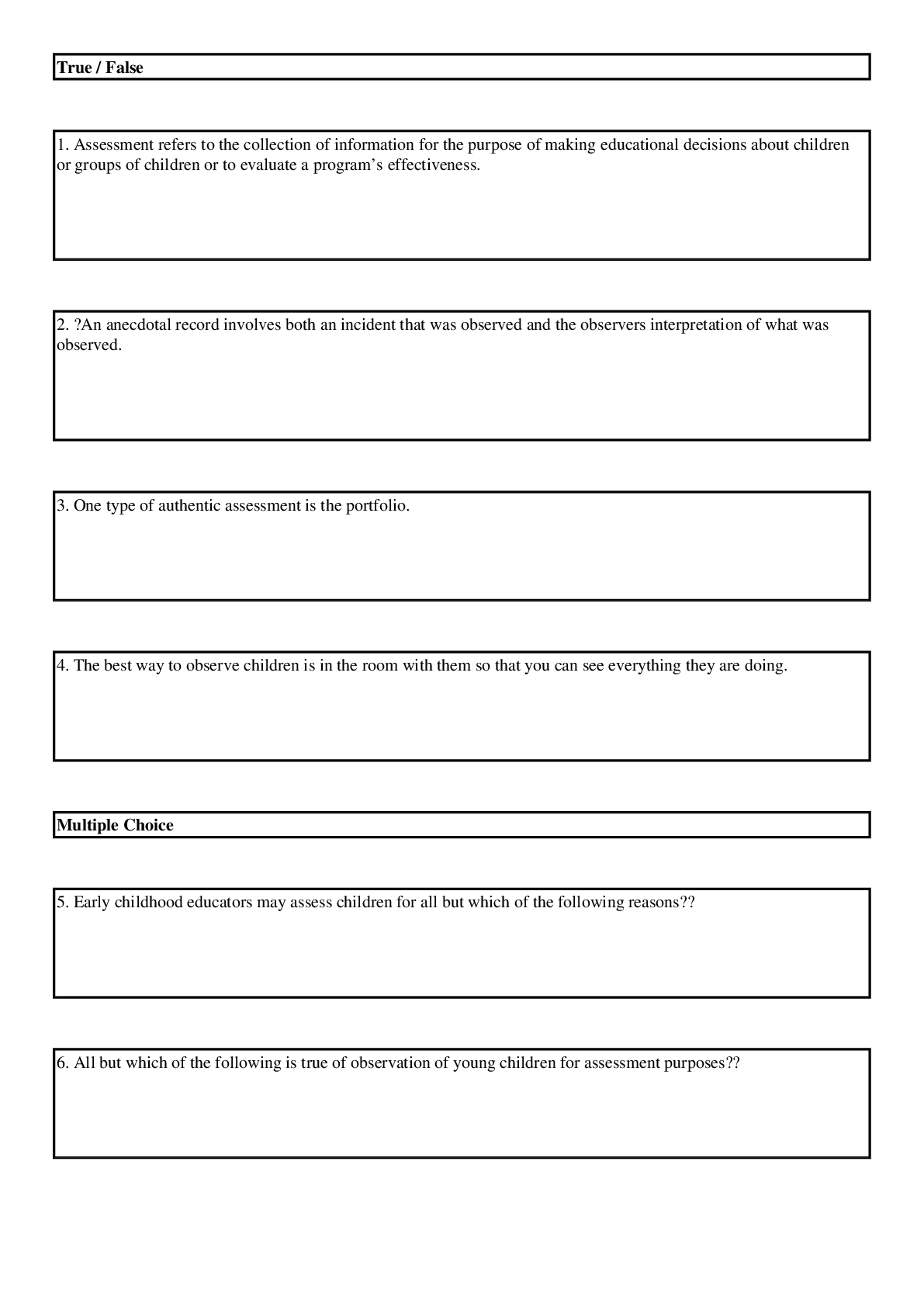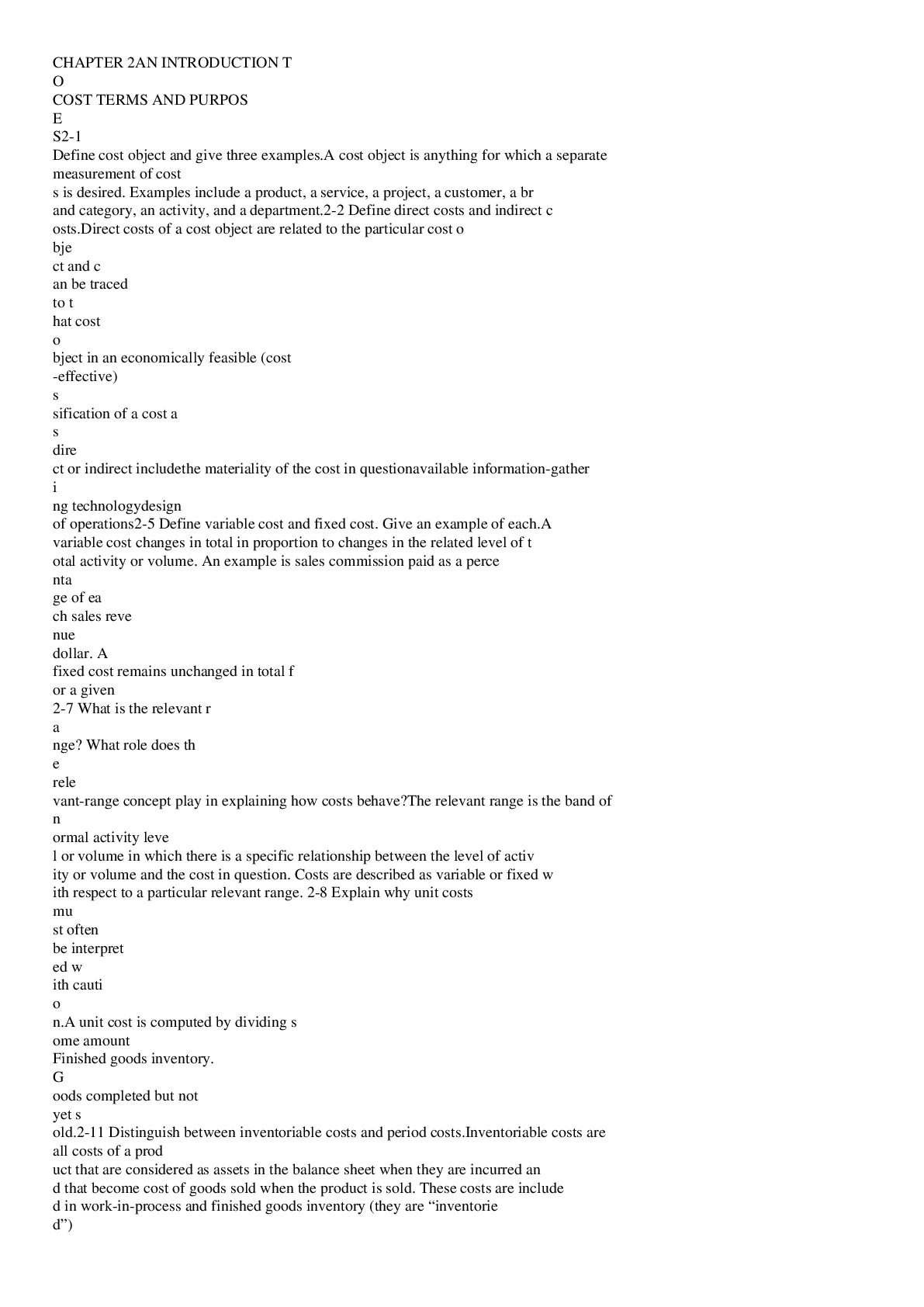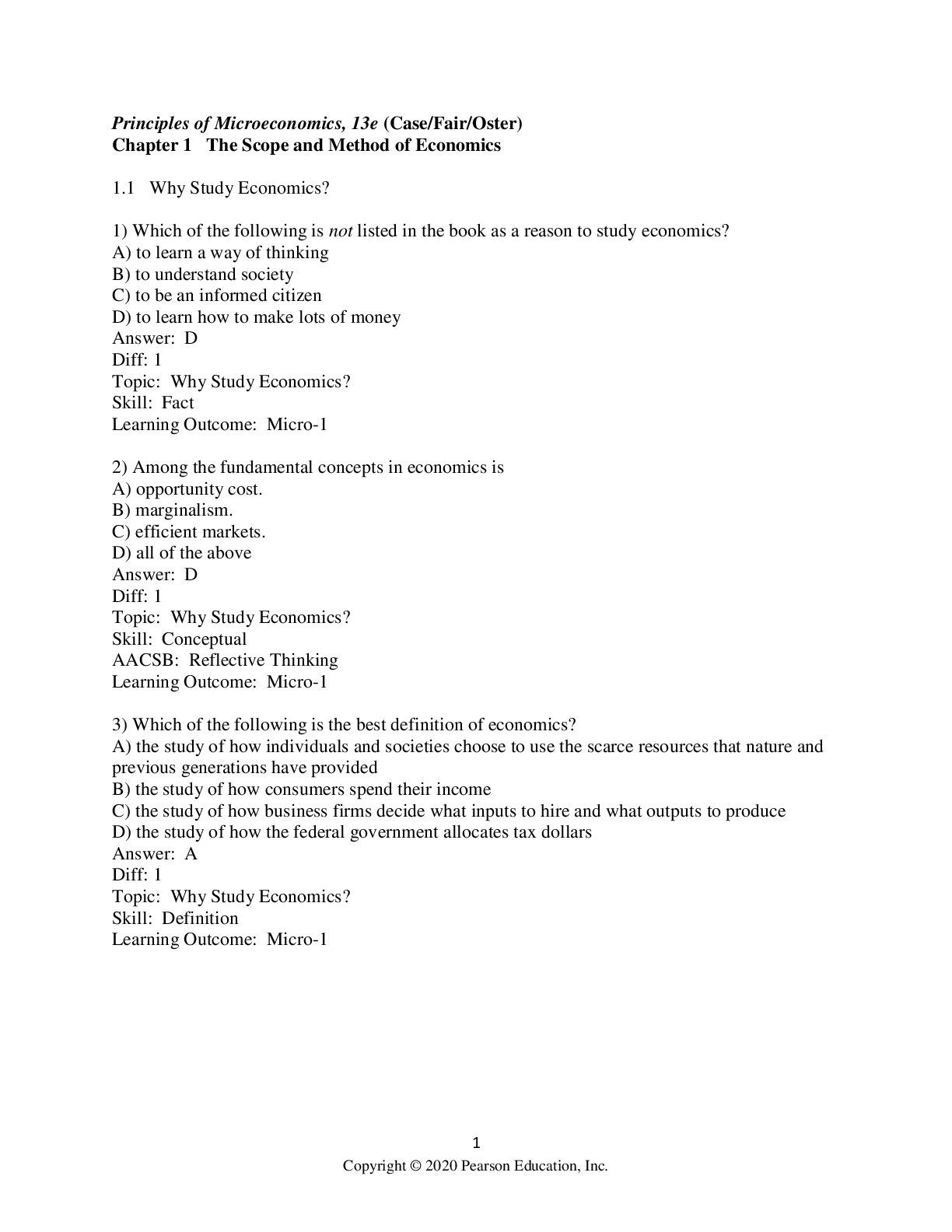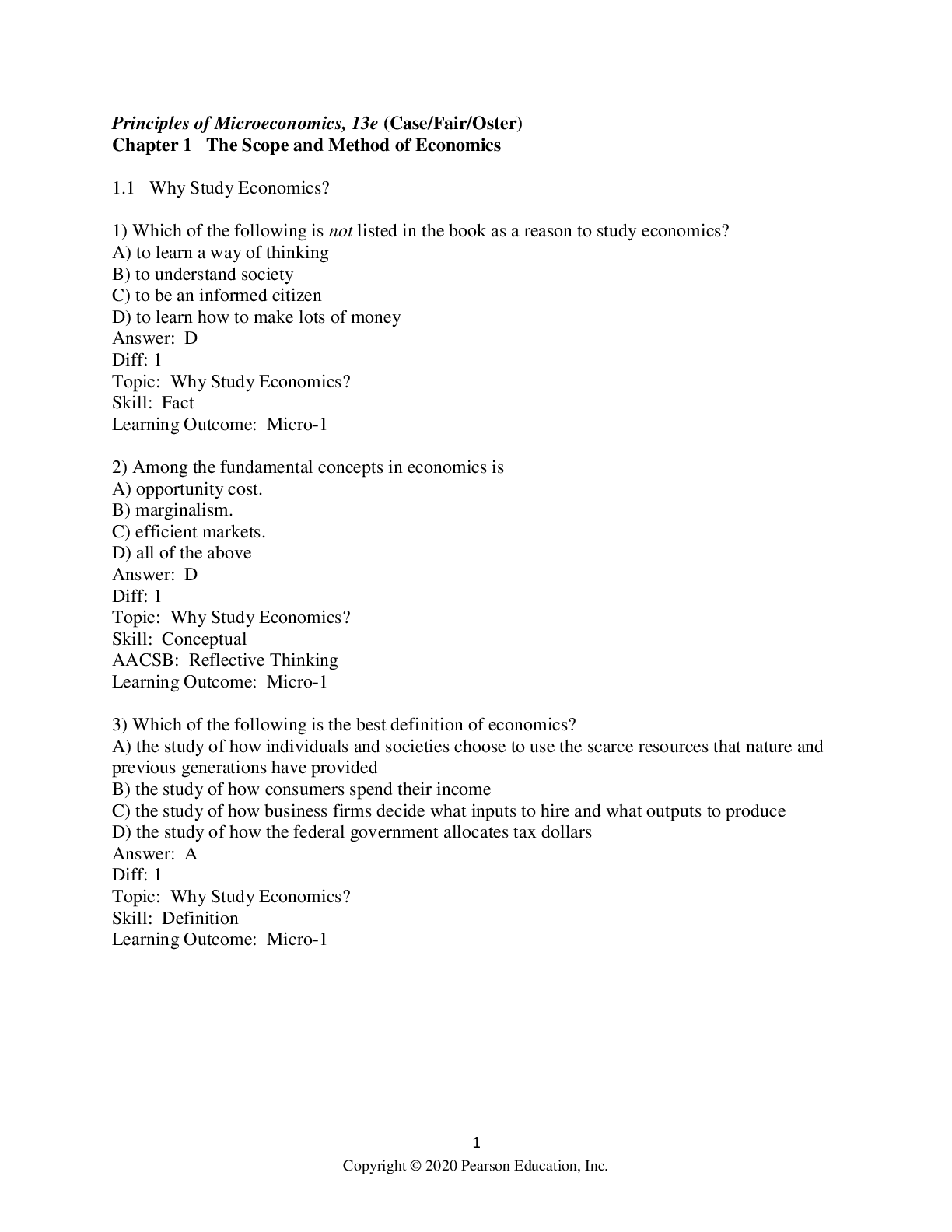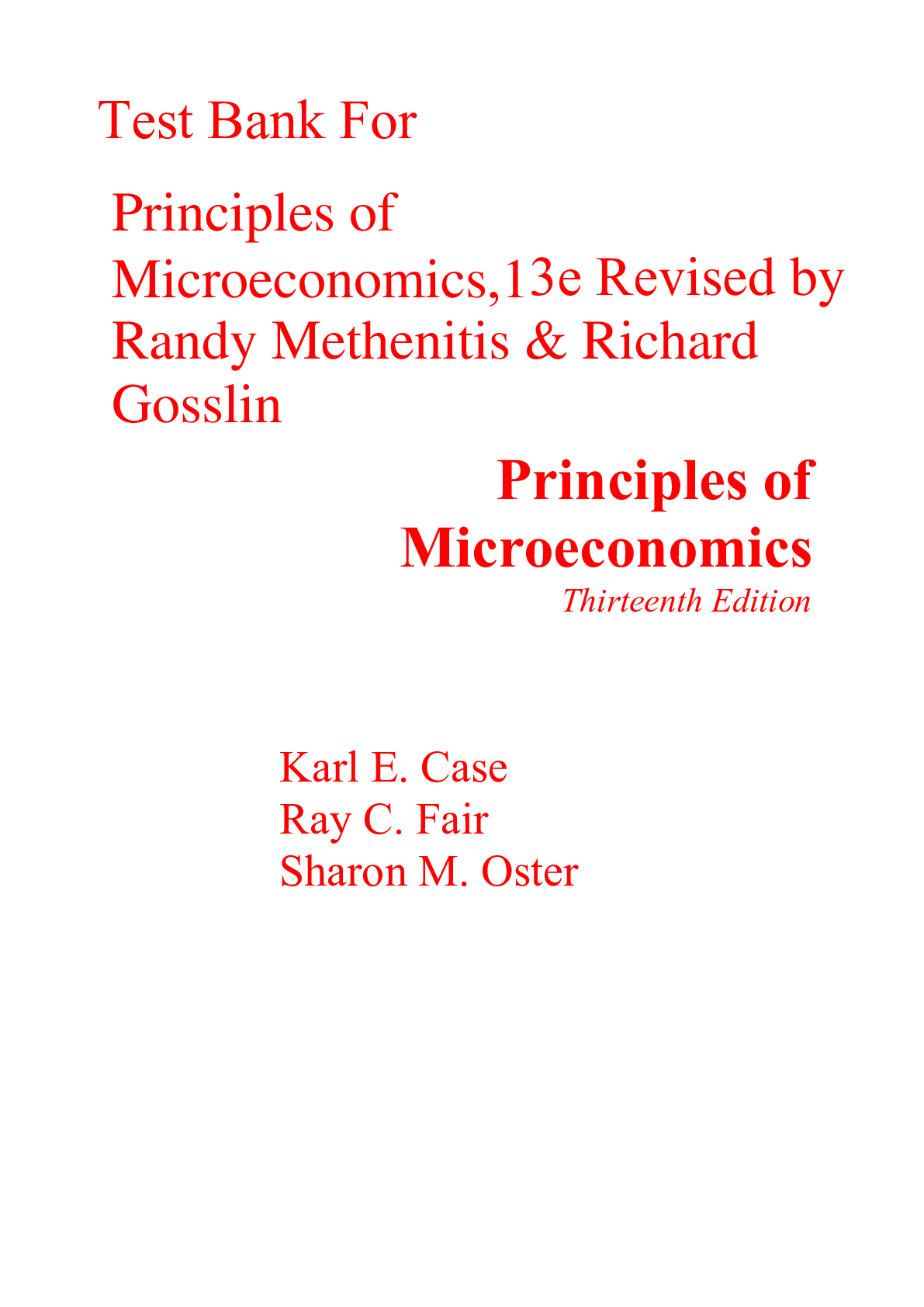Macroeconomics > TEST BANK > Test Bank Microeconomics 13th Edition by Arnold (All)
Test Bank Microeconomics 13th Edition by Arnold
Document Content and Description Below
True / False 1. By definition, monopolists sell a product for which there are absolutely no substitutes. a. True b. False ANSWER: False 2. Legal barriers to entry include patents, g... overnment licenses and economies of scale. a. True b. False ANSWER: False 3. The single-price monopolist produces the quantity of output at which marginal cost equals marginal revenue and charges a price that is greater than marginal revenue. a. True b. False ANSWER: True 4. Price discrimination occurs when a seller charges different prices for its product and the price differences result from differences in the costs of production. a. True b. False ANSWER: False 5. The perfectly price-discriminating monopolist achieves resource allocative efficiency, while the single-price monopolist does not. a. True b. False ANSWER: True 6. Third-degree price discrimination is sometimes called discrimination among buyers. a. True b. False ANSWER: True 7. If a firm has no variable costs, the profit-maximizing price is also the revenue-maximizing price. a. True b. False ANSWER: True 8. Monopolists are guaranteed to earn a positive economic profit because they are the only seller in their industry. a. True b. False ANSWER: False 9. A monopolist that practices perfect price discrimination has the same deadweight loss triangle as the single-price monopolist. a. True b. False ANSWER: False 10. The monopolist's demand curve is perfectly inelastic. a. True b. False ANSWER: False 11. One of the conditions necessary for price discrimination is that the seller be a price searcher. a. True b. False ANSWER: True 12. The U.S. Postal Service is an example of a public franchise. a. True b. False ANSWER: True 13. Economic rent is a payment received in excess of marginal cost. a. True b. False ANSWER: False 14. The Townsend Acts, passed by the British Parliament in 1767, imposed taxes on various products imported into the American colonies. a. True b. False ANSWER: True 15. At one time, monopolies were granted to people who were in the favor of kings and queens. a. True b. False ANSWER: True 16. X-inefficiency occurs when a monopolist produces output at a cost that is greater than the lowest possible cost. a. True b. False ANSWER: True 17. When a store offers an incentive for buying more, such as charging $50 for one sweater or $90 for two sweaters, it is an example of price discrimination. a. True b. False ANSWER: True 18. Cents-off coupons can be seen as a form of third-degree price discrimination. a. True b. False ANSWER: True 19. The profit-maximizing monopolist produces the quantity of output at which marginal revenue equals marginal cost. a. True b. False ANSWER: True 20. One of the assumptions of the theory of monopoly is that the single seller sells a product for which there are no close substitutes. a. True b. False ANSWER: True 21. At the profit-maximizing level of output, price is greater than marginal cost for a seller practicing perfect price discrimination. a. True b. False ANSWER: False 22. A single-price monopolist receives the maximum price for each unit of the good it sells; a perfectly price-discriminating monopolist does not. a. True b. False ANSWER: False Multiple Choice 23. Which of the following is an assumption of the theory of monopoly? a. There are extremely high barriers to entry. b. There are many sellers. c. The product has a number of close substitutes. d. The product is of extremely high quality. ANSWER: a 24. The theory of monopoly assumes that the monopoly firm a. faces a downward-sloping supply curve that is the same as its marginal revenue curve. b. faces a downward-sloping demand curve. c. produces more than the perfectly competitive firm under identical demand and cost conditions. d. produces a product for which there are many close substitutes. ANSWER: b 25. Firm X is a single seller of good X. There are, however, two substitutes for good X. Given this, firm X a. cannot be a monopolist because the theory of monopoly assumes there are no substitutes for the good the single seller sells. b. may be a monopolist because the two substitutes may be close substitutes. c. cannot be a monopolist because if substitutes exist for the good it produces, its demand curve is horizontal but monopolists face downward-sloping demand curves. d. must be selling its product in a perfectly competitive market. ANSWER: b 26. Suppose firm X is a monopolist and is receiving positive economic profits. What prevents other firms from directly competing away the profits? a. high barriers to entry b. antitrust laws c. low barriers to entry d. diseconomies of scale ANSWER: a 27. Which of the following is an example of a legal barrier to entry? a. a public franchise b. advertising c. exclusive ownership of a scarce resource d. diseconomies of scale ANSWER: a 28. A public franchise is a right granted a. to one firm by another firm; for example, McDonald's Corporation grants restaurant owners a franchise to make its hamburgers. b. to a firm by government that prevents other firms from producing the same product or service. c. to a cooperative of buyers that allows the group to purchase goods at wholesale prices. d. by government that enables a person to engage in arbitrage. ANSWER: b 29. A natural monopoly exists when a. a monopolist produces a product, the main component of which is a natural resource. b. economies of scale are so large that only one firm can survive and achieve low unit costs. c. a firm is the exclusive owner of a key resource necessary to produce the firm’s product. d. there are no close substitutes for a firm's product. ANSWER: b 30. Which of the following is the best example of a monopoly? a. a local public utility b. a fast-food restaurant c. a department store d. a wheat farmer ANSWER: a 31. Which of the following is the best example of a barrier to entry into a monopolistic industry? a. diminishing returns b. comparative advantage c. high price elasticity of demand d. a public franchise ANSWER: d 32. Public franchises, patents, and government licenses are examples of __________ barriers to entry. a. social b. legal c. cultural d. geographic ANSWER: b 33. A right granted to a firm by government that permits the firm to provide a particular good or service and excludes others from doing the same is called a. a natural monopoly. b. a comparative advantage. c. an economy of scale. d. a public franchise. ANSWER: d 34. Which of the following is not an example of a legal barrier to entry? a. a public franchise b. economies of scale c. a government license d. a patent ANSWER: b 35. Which of the following is not an example of a legal barrier to entry? a. a beautician's license b. a patent c. exclusive ownership of raw materials d. a public franchise e. a copyright ANSWER: c 36. If economies of scale are so pronounced in an industry that only one firm can survive in the industry, this firm is called a(n) __________ monopoly. a. financial b. natural c. structured d. independent ANSWER: b 37. A monopoly may exist because a. government has refused to grant a public franchise. b. one firm has the exclusive ownership of a necessary resource. c. the firm is so large and is currently experiencing such vast diseconomies of scale that it can out-compete all newcomers. d. of diseconomies of scale. ANSWER: b 38. A seller that has the ability (to some degree) to control the price of the product it sells is called a price a. taker. b. searcher. c. breaker. d. twister. ANSWER: b 39. In the United States, patents are granted to inventors of a product or process for a period of a. unlimited time. b. 10 years. c. 20 years. d. 25 years. ANSWER: c 40. A price searcher a. faces a horizontal demand curve. b. is a seller that searches for good employees and pays them a low wage. c. is a seller that searches for the best location to sell its product. d. is a seller that has the ability to control to some degree the price of the product it sells. ANSWER: d 41. Which of the following statements is false? a. A price searcher must lower price to sell an additional unit of its product. b. For a price searcher, price equals marginal revenue for all units except the first. c. For a price searcher, price is greater than marginal revenue for all units except the first. d. A price searcher, like a price taker, produces that quantity of output for which marginal revenue equals marginal cost. ANSWER: b 42. A price searcher is a. a person who actively seeks out the best price for a product that he or she wishes to buy. b. a firm that seeks out buyers who are willing to pay the price that the seller is asking for the product. c. a firm that has the ability to control to some degree the price of the product it sells. d. actually any firm or consumer, because each market "player" searches for the best price at which it can sell or buy. ANSWER: c 43. Which of the following statements is true? a. A monopolist can charge whatever price it wants without losing any customers, by virtue of its monopoly position. b. A monopolist may be able to increase its profits by increasing its price. c. In the monopoly market structure, there are low barriers to entry. d. A monopolist is assured of positive economic profits. ANSWER: b 44. For the monopoly firm that does not engage in perfect price discrimination, a. the marginal revenue curve lies below the demand curve. b. the marginal revenue curve and demand curve are the same. c. the marginal revenue curve lies above the demand curve. d. marginal revenue equals price. ANSWER: a 45. Which of the following statements is false? a. The monopolist faces a horizontal demand curve. b. For the single-price monopolist, marginal revenue is less than price. c. For the monopolist, revenue maximization and profit maximization are usually not the same. d. The monopolist is a price searcher. ANSWER: a 46. Which of the following statements is true? a. The monopolist can sell all it can produce at the market price. b. The marginal revenue curve of the single-price monopolist lies above its demand curve. c. The marginal revenue curve of the single-price monopolist is the same as its demand curve. d. The marginal revenue curve of the single-price monopolist lies below its demand curve. ANSWER: d 47. Which of the following statements is false? a. The monopolist has the ability to control to some degree the price of the product it sells. b. The monopolist faces a downward-sloping demand curve. c. The monopolist is a price taker. d. The monopoly firm is the industry. ANSWER: c 48. In maximizing profits, a single-price monopolist will charge a price that is a. less than marginal cost. b. equal to marginal cost. c. greater than marginal cost. d. There is not enough information to answer the question. ANSWER: c 49. If a monopolist wishes to sell an additional unit of the good, then a. it must raise its price to signal consumers that its product is now a more important part of their budget, and they will purchase more. b. like a competitive firm, it can simply make more output available and not lower price. c. it must lower price. d. it can raise price and not worry that sales will decrease. ANSWER: c 50. Maximizing total revenue turns out to be the same as maximizing profit only when a. average fixed cost declines continually as output rises. b. a firm has no fixed costs. c. a firm has no variable costs. d. a firm has both variable and fixed costs. ANSWER: c 51. A monopolist can sell 8,000 units at a price of $10 per unit. Lowering price to all buyers by $1 raises the quantity demanded by 500 units. What is the change in total revenue resulting from this price change? a. $3,500 b. -$12,500 c. -$3,500 d. -$18,000 e. There is not enough information provided to answer the question. ANSWER: c 52. A monopolist can sell 26,000 units at a price of $30 per unit. Lowering price by $1 raises the quantity demanded by 1,000 units. What is the change in total revenue resulting from this price change? a. $1,500 b. $3,000 c. $5,500 d. -$2,800 ANSWER: b 53. A monopolist maximizes profits at the output at which a. total revenue is at its greatest, assuming that the firm has both fixed and variable costs. b. price equals marginal cost. c. price exceeds marginal cost by the greatest amount. d. marginal revenue equals marginal cost. ANSWER: d 54. Which of the following is characteristic of the monopoly firm? a. It produces the quantity of output at which marginal revenue equals marginal cost, MR = MC. b. It charges a price per unit for its product that is equal to marginal cost. c. It always earns a profit, because it is a single seller of a product. d. It charges a price per unit for its product that is less that its marginal cost. ANSWER: a 55. Which of the following statements is true? a. As a consequence of the monopoly firm producing the quantity of output at which price equals marginal cost, it is resource allocative efficient. b. As a consequence of the perfectly competitive firm producing the quantity of output at which price equals marginal cost, it is resource allocative efficient. c. As a consequence of the perfectly competitive firm producing the quantity of output at which price equals marginal cost, it is productive efficient. d. As a consequence of the monopoly firm producing the quantity of output at which price equals marginal cost, it is productive efficient. ANSWER: b 56. In order for a monopolist to be earning a profit, price must be greater than a. average total cost. b. marginal revenue. c. total cost. d. marginal cost. ANSWER: a 57. For a monopolist, if price is above average total cost, the monopolist is a. earning an economic profit. b. taking an economic loss. c. minimizing total fixed costs. d. minimizing total variable costs. ANSWER: a 58. The Townsend Acts a. are anti-trust laws passed in the U.S. in the 1930's to limit monopoly power. b. allow district attorneys the opportunity to plea bargain with accused criminals. c. were British laws enacted in the 1760's that imposed taxes on products imported to the American colonies, leading (in part) to the Boston Tea Party. d. were enacted in the late 1800's to permit regulation of natural monopolies. ANSWER: c 59. The perfectly competitive firm charges a price equal to __________ while the monopolist charges a price __________. a. marginal revenue; equal to marginal cost b. marginal cost; greater than marginal cost c. marginal revenue; less than marginal revenue d. average total cost; greater than average total cost ANSWER: b 60. Economic rent is a payment in excess of a. average fixed cost. b. average variable cost. c. opportunity cost. d. explicit cost, but not necessarily implicit cost. ANSWER: c 61. Rent seeking occurs when the seller a. charges different prices for the product it sells, and the price differences do not reflect cost differences. b. charges the highest price each consumer would be willing to pay for the product rather than go without it. c. charges a uniform price per unit for one specific quantity, a lower price for an additional quantity, and so on. d. spends resources to influence public policy in the hope of transferring income to themselves from others. ANSWER: d 62. The seller of good X sells 1,000 units of the good. Each unit is being sold for the highest price each consumer is willing to pay for the good. The seller practices a. second-degree price discrimination. b. third-degree price discrimination. c. perfect price discrimination. d. marginal revenue pricing. e. rent seeking. ANSWER: c 63. Perfect price discrimination is discrimination among a. units. b. quantities. c. buyers. d. prices. ANSWER: a 64. Third-degree price discrimination is discrimination among a. units. b. quantities. c. buyers. d. prices. ANSWER: c 65. Second-degree price discrimination is discrimination among a. units. b. quantities. c. buyers. d. prices. ANSWER: b 66. Which of the following is not a necessary condition for price discrimination to hold? a. The seller must be a price searcher. b. The seller must be able to distinguish between customers willing to pay different prices. c. It must cost the seller more to service some customers than others. d. Reselling the product must be extremely costly or must not be possible ANSWER: c 67. For a firm that perfectly price discriminates, a. price is less than marginal revenue. b. price is greater than marginal revenue. c. price equals marginal revenue. d. price has no definite relationship with marginal revenue. ANSWER: c 68. A monopolist practicing (perfect) price discrimination has a. a larger deadweight loss triangle than a single-price monopolist has. b. the same deadweight loss triangle as a single-price monopolist. c. a deadweight loss triangle one-half the size of what it would be with uniform pricing. d. no deadweight loss triangle. ANSWER: d 69. If a monopolist practices perfect price discrimination, then it will have a. a greater total revenue and sell a greater output than if it were not practicing price discrimination. b. a smaller total revenue and sell a smaller output than if it were not practicing price discrimination. c. the same total revenue but sell a larger output than if it were not practicing price discrimination. d. the same total revenue but sell a smaller output than if it were not practicing price discrimination. ANSWER: a 70. Suppose a monopolist practices perfect price discrimination. Its marginal revenue curve a. will lie below its demand curve. b. will lie above its demand curve. c. will coincide with its demand curve. d. has no definite relationship with its demand curve. ANSWER: c 71. Suppose the local pharmacy charges lower prices to senior citizens than it charges to younger customers. The pharmacy is practicing a. perfect price discrimination. b. second-degree price discrimination. c. arbitrage. d. third-degree price discrimination. e. non-cost discrimination. ANSWER: d 72. Suppose that your school pays one rate for the first one million kilowatts of electricity and a lower rate for any power it uses over one million kilowatts. What economic concept is occurring here? a. perfect price discrimination b. second-degree price discrimination c. third-degree price discrimination d. economies of scale ANSWER: b 73. Suppose Johnny, seven years old, is selling lemonade to his neighbors and he sells each of his buyers the refreshment for the maximum price that each buyer is willing to pay. Johnny is practicing a. perfect competition. b. perfect price discrimination. c. second-degree price discrimination. d. third-degree price discrimination. ANSWER: b 74. Arbitrage is a. a form of negotiation between two parties having a disagreement. b. buying a good in one market and selling it in another for a profit. c. a form of price discrimination where the producer sells its product at two different prices. d. a means of deciding the most efficient way of producing a product. ANSWER: b 75. Which of the following statements is false? a. The perfectly competitive firm and the perfectly price-discriminating monopolist both exhibit resource-allocative efficiency. b. The perfectly competitive firm, unlike the single-price monopolist, exhibits resource-allocative efficiency. c. The perfectly competitive firm charges the same price for each unit of the good it sells. d. The perfectly price-discriminating monopolist charges the same price for each unit of the good it sells. ANSWER: d 76. If a perfectly competitive firm and a single-price monopolist face the same demand and cost curves, then the competitive firm will produce a a. greater output and charge a lower price than the monopolist. b. greater output but charge the same price as the monopolist. c. greater output and charge a higher price than the monopolist. d. smaller output and charge a lower price than the monopolist. e. smaller output and charge a higher price than the monopolist. ANSWER: a 77. If a perfectly competitive firm and a single-price monopolist face the same demand and cost curves, then a. the competitive firm will attain resource-allocative efficiency, but the monopolist will not. b. the competitive firm will attain resource-allocative efficiency, but the monopolist may or may not, depending upon the demand for its product. c. the competitive firm will not attain resource-allocative efficiency, but the monopolist will. d. both the competitive firm and the monopolist will attain resource-allocative efficiency. e. neither the competitive firm nor the monopolist will attain resource-allocative efficiency. ANSWER: a 78. If a perfectly competitive firm and a perfectly price-discriminating monopolist face the same demand and cost curves, then a. the competitive firm will attain resource-allocative efficiency, but the monopolist will not. b. the competitive firm will attain resource-allocative efficiency, but the monopolist may or may not, depending upon the demand for its product. c. the competitive firm will not attain resource-allocative efficiency, but the monopolist will. d. both the competitive firm and the monopolist will attain resource-allocative efficiency. e. neither the competitive firm nor the monopolist will attain resource-allocative efficiency. ANSWER: d 79. If a single-price monopolist and a perfectly price-discriminating monopolist face the same demand and cost curves, then a. the single-price monopolist will attain resource-allocative efficiency, but the discriminating monopolist will not. b. the single-price monopolist will attain resource-allocative efficiency, but the discriminating monopolist may or may not, depending upon the demand for its product. c. the single-price monopolist will not attain resource-allocative efficiency, but the discriminating monopolist will. d. both the single-price and the discriminating monopolist will attain resource-allocative efficiency. e. neither the single-price nor the discriminating monopolist will attain resource-allocative efficiency. ANSWER: c 80. Which of the following statements is true? a. The perfectly competitive firm produces a level of output at which P > MC. b. The single-price monopolist produces a level of output at which P > MC. c. The perfectly price-discriminating monopolist produces a level of output at which P>MC. d. The single-price monopolist produces a level of output at which P = MC. ANSWER: b Exhibit 23-1 81. Refer to Exhibit 23-1. If the product is produced under single-price monopoly, what quantity will be produced and what price will be charged in order to maximize profit? a. Q2 units at P1 b. Q1 units at P1 c. Q1 units at P2 d. Q2 units at P2 ANSWER: c 82. Refer to Exhibit 23-1. If the product is produced under single-price monopoly, what do profits equal at the profit maximizing level of output? a. area 0P1BQ1 b. area BCA c. area P1P2CB d. area P2CAP1 ANSWER: c 83. Refer to Exhibit 23-1 The deadweight loss of the profit-maximizing monopoly is identified by what area? a. area Q1BAQ2 b. area BCA c. area P1P2CB d. area 0P1BQ1 ANSWER: b 84. Refer to Exhibit 23-1. According to economist Gordon Tullock, what area is subject to rent seeking activity? a. area Q1BAQ2 b. area BCA c. area P1P2CB d. area 0P1BQ1 ANSWER: c 85. Refer to Exhibit 23-1. If the product is produced under single-price monopoly, what does total revenue equal at the profit maximizing level of output? a. area 0P2CQ1 b. area BCA c. area P1P2CB d. area P2CAP1 ANSWER: a 86. Refer to Exhibit 23-1. If the product is produced under single-price monopoly, what do total costs equal at the profit maximizing level of output? a. area 0P1BQ1 b. area BCA c. area P1P2CB d. area P2CAP1 ANSWER: a 87. For the perfectly competitive firm, price ________ MR; for the monopolist price ______ MR. The perfectly competitive firm's demand curve _______ its marginal revenue curve; the monopolist's demand curve ____________ its marginal revenue curve. a. equals; is less than; is; lies below b. less than; greater than; lies below; lies above c. greater than; equals; lies above; is d. equals; is greater than; is; lies above ANSWER: d 88. Individuals who spend resources to influence public policy in a way that will redistribute income to themselves are a. stabilizing the economy. b. rent seeking. c. engaging in collusion. d. minimizing explicit costs. ANSWER: b 89. "Rent seeking" is socially wasteful because a. resources devoted to transferring rents are not used to produce goods. b. wage income is converted into profit income. c. it results in higher prices than would exist without monopoly. d. it discourages innovation and risk taking. ANSWER: a 90. Barriers to entry include all of the following except a. exclusive ownership of a scarce resource. b. patents. c. public franchises. d. diseconomies of scale. e. government licenses. ANSWER: d 91. In general, electric, gas, and water companies are examples of __________ monopolies. a. unregulated b. patent c. natural d. government ANSWER: c 92. The demand curve facing a monopolist is always a. the same as the industry demand curve. b. perfectly inelastic. c. perfectly elastic. d. unit elastic. ANSWER: a 93. By adhering to the MR = MC rule, a single-price monopoly a. will always have an above-zero profit. b. will always have a normal profit. c. maximizes its profit, which may in some cases mean minimizing its losses. d. is not earning as large a profit as it can by setting MR = (MC - P). ANSWER: c 94. If a price-discriminating monopoly charges a lower price to individuals in city X, it is likely that the firm a. believes that the demand of individuals in city X is relatively inelastic. b. believes that the demand of individuals in city X is relatively elastic. c. wants to shift the demand of individuals in city X. d. cares about the well-being of the individuals in city X. ANSWER: b 95. At the level of output at which a single-price monopolist maximizes profit, price is a. equal to marginal cost. b. equal to marginal revenue. c. greater than marginal cost. d. less than marginal cost. e. less than marginal revenue. ANSWER: c 96. A single-price monopolist sets its price for good X at $75 and is selling more than one unit of good X. Which of the following must be true? a. The average cost of that unit must be $75. b. The marginal cost of that unit must be $75. c. The marginal revenue of that unit must be $75. d. The marginal revenue of that unit must be less than $75. ANSWER: d 97. A monopolist can sell 10,000 units at a price of $17. Lowering price by $2 raises the quantity demanded by 2,000 units. What is the change in total revenue that results from this price change? a. $10,000 b. $4,000 c. $180,000 d. $90,000 ANSWER: a 98. For a single-price monopoly, marginal revenue is a. equal to price for all levels of output. b. less than price for all units of output after the first unit. c. greater than price. d. horizontal. ANSWER: b 99. The term "arbitrage" refers to a. buying a good in a market where its price is high and selling the good in another market where its price is lower. b. buying a good in a market where its price is low and selling the good in another market where its price is higher. c. selling a good in a market where its price is high. d. selling a good in a market where its price is low. ANSWER: b 100. Which of the following is true at the level of output which maximizes profits for a perfectly price-discriminating monopolist? a. P > MC. b. P < ATC. c. P < MC. d. P = MC. ANSWER: d Exhibit 23-2 101. Refer to Exhibit 23-2. The profit-maximizing monopolist produces Q0 units and charges a price of a. P0. b. P1. c. P3. d. P2. ANSWER: c 102. Refer to Exhibit 23-2. Total revenue at the profit-maximizing quantity of output is the a. area 0P0AQ0. b. area 0P3FQ0. c. distance from Q0 to A. d. distance from Q0 to D. ANSWER: b 103. Refer to Exhibit 23-2. This monopolist is earning a. an economic loss of area P0P3FA. b. an economic loss of area P0P2CA. c. an economic profit of area P2P3FC. d. an economic profit of area P0P2CA. ANSWER: c 104. Refer to Exhibit 23-2. Total cost at the profit-maximizing quantity of output is the a. area 0P2CQ0. b. area 0P3FQ0. c. area 0P1BQ0. d. distance from Q0 to D. ANSWER: a 105. The monopoly firm may earn positive economic profits in the long run because a. it produces a homogeneous product. b. it is resource allocative efficient. c. of high barriers to entry. d. it is productive efficient. ANSWER: c 106. X-inefficiency refers to a. the tendency for an economy to allocate too many resources to the monopolist. b. the increase in costs and organizational slack in a monopoly resulting from the lack of competitive pressure. c. the resources used to regulate the behavior of a monopolist. d. the decrease in costs resulting from monopoly power. ANSWER: b 107. The monopolist's demand curve is a. upward sloping. b. perfectly elastic. c. perfectly inelastic. d. downward sloping. ANSWER: d 108. The monopolist's marginal revenue curve is a. downward sloping and lies below the firm’s demand curve. b. upward sloping and lies above the firm’s demand curve. c. perfectly inelastic. d. downward sloping and lies above the firm’s demand curve. e. the same as the industry demand curve. ANSWER: a 109. The profit-maximizing single-price monopolist will charge a price a. equal to marginal revenue. b. greater than marginal cost. c. less than marginal revenue, but greater than marginal cost. d. greater than marginal revenue, but equal to marginal cost. ANSWER: b Exhibit 23-3 110. Refer to Exhibit 23-3. The profit-maximizing single-price monopolist charges price a. P1. b. P2. c. P3. d. P4. e. P5. ANSWER: e 111. Refer to Exhibit 23-3. The profit-maximizing single-price monopolist produces output a. q1. b. q2. c. q3. d. q4. ANSWER: a 112. Refer to Exhibit 23-3. The profit of the single-price monopolist is a. positive. b. zero. c. negative. d. uncertain without more information. ANSWER: a 113. Refer to Exhibit 23-3. The level of output the profit-maximizing perfectly price-discriminating monopolist produces is a. q1. b. q2. c. q3. d. q4. ANSWER: c 114. To engage in price discrimination, it is necessary that a. a seller be a price searcher. b. there be the possibility of arbitrage. c. a seller incur different costs for servicing different customers. d. a seller be a price taker. ANSWER: a 115. A monopoly exhibits resource-allocative efficiency if it a. is a single-price monopolist. b. is a perfectly price-discriminating monopolist. c. engages in second-degree price discrimination. d. engages in third-degree price discrimination. ANSWER: b Exhibit 23-4 Price Quantity Demanded Total Fixed Cost Total Variable Cost Total Revenue Total Cost Marginal Revenue Marginal Cost $50 0 $8 $0 (C) (H) 45 1 8 20 (D) (I) (L) (R) 40 2 (A) 30 (E) (J) (M) (S) 35 3 8 55 105 63 (N) (T) 30 4 8 (B) (F) 93 (P) (U) 25 5 8 125 (G) (K) (Q) (V) 116. Refer to Exhibit 23-4. The profit-maximizing single-price monopolist will produce a. 3 units. b. 4 units. c. 5 units. d. 6 units. ANSWER: a 117. Refer to Exhibit 23-4. The profit-maximizing single-price monopolist's maximum profit is a. $22. b. $42. c. $82. d. $130. e. $140. ANSWER: b 118. Refer to Exhibit 23-4. What dollar amounts go in blanks (A), (B), (C), (D), and (E), respectively? a. $8; $60; $0; $10; and $130 b. $8; $70; $50; $30; and $10 c. $25; $10; $10; $30; and $50 d. $8; $85; $0; $45; and $80 ANSWER: d 119. Refer to Exhibit 23-4. What dollar amounts go in blanks (F), (G), (H), (I), and (J), respectively? a. $120; $125; $8; $28; and $38 b. $9; $70; $50; $30; and $10 c. $250; $15; $10; $30; and $50 d. $100; $90; $8; $28; and $48 ANSWER: a 120. Refer to Exhibit 23-4. What dollar amounts go in blanks (K), (L), (M), and (N), respectively? a. $90; $80; $53.33; and $60 b. $90; $70; $50; and $30 c. $133; $45; $35; and $25 d. $0; $90; $160; and $210 ANSWER: c 121. Refer to Exhibit 23-4. What dollar amounts go in blanks (P), (Q), (R), and (S), respectively? a. $90;$80; $53.33; and $60 b. $10; $0; $28; and $19 c. $15; $5; $20; and $10 d. $75; $45; $33.33; and $32.50 ANSWER: c 122. Refer to Exhibit 23-4. What dollar amounts go in blanks (T), (U) and (V), respectively? a. $25; $30; and $40 b. $16; $19.50; and $23.60 c. $30; $40; and $29 d. $23; $15; and $28 ANSWER: a Exhibit 23-5 123. Refer to Exhibit 23-5. What area represents the revenue gained when price goes from P2 to P1? a. P1CBP2 b. q2CAq1 c. 0P1Aq1 d. CBA ANSWER: b 124. Refer to Exhibit 23-5. What area represents lost revenue when price goes from P2 to P1? a. CBA b. 0P1Cq2 c. q2CAq1 d. P1P2BC ANSWER: d 125. Refer to Exhibit 23-5. Suppose a single-price monopolist sells its product at the price P2. Profits are equal to a. P2 times q2. b. (P2 - P1) times q2. c. (P2 - P1) times (q1 - q2). d. This cannot be determined without the average total cost curve. ANSWER: d 126. Which of the following is true of price and marginal revenue for the first unit of output sold by a monopolist? a. Price is greater than marginal revenue. b. Price is less than marginal revenue. c. Price is equal to marginal revenue. d. There is no relationship between price and marginal revenue. ANSWER: c Exhibit 23-6 127. Refer to Exhibit 23-6. The price and quantity of a single-price monopolist producing good X are P0 and qB, respectively. The marginal revenue curve is represented by a. A. b. B. c. C. d. D. ANSWER: a 128. Refer to Exhibit 23-6. The marginal revenue curve of a perfectly competitive firm producing X and selling it at the price P0 is represented by a. A. b. B. c. C. d. D. ANSWER: d 129. Refer to Exhibit 23-6. If C is the demand curve facing a perfectly price-discriminating monopolist selling qC units of X, its marginal revenue curve is a. A. b. B. c. C. d. D. ANSWER: c 130. Refer to Exhibit 23-6. Let C be the demand curve facing a perfectly price-discriminating monopolist and P0 the price it charges for the last unit of X it sells. The marginal cost of the last unit a. is less than P0. b. equals P0. c. is greater than P0. d. There is not enough information provided to answer this question. ANSWER: b Exhibit 23-7 131. Refer to Exhibit 23-7. The maximum profits earned by a single-price monopolist producing good X are a. $9,000. b. $4,500. c. $2,250. d. $1,125. ANSWER: c 132. Refer to Exhibit 23-7. The total revenue collected by a profit-maximizing single-price monopolist is a. $4,500. b. $2,250. c. $6,750. d. $9,000. ANSWER: c 133. Refer to Exhibit 23-7. Let D be the demand curve facing a perfectly price-discriminating monopolist. The lowest price this monopolist will charge is a. $60. b. $45. c. $30. d. $0. ANSWER: c 134. Refer to Exhibit 23-7. Let D be the demand curve facing a perfectly price-discriminating monopolist. The marginal revenue it receives from selling the 150th unit of good X sold equals a. $60. b. $45. c. $30. d. $0, since it sells less than 150 units. ANSWER: b 135. Refer to Exhibit 23-7. If D represents the demand curve facing a perfectly price-discriminating monopolist, the price it charges for the last unit sold exceeds the marginal cost of the last unit by a. $30. b. $15. c. $0. d. an amount that cannot be determined without the average cost curve. ANSWER: c 136. Competition is legally prohibited when barriers to entry take the form of a. public franchises. b. economies of scale. c. exclusive ownership of a resource. d. diseconomies of scale. ANSWER: a Exhibit 23-8 Quantity Total Revenue Total Cost 2 $300 $170 3 $360 $190 4 $400 $220 5 $450 $270 6 $480 $340 137. Refer to Exhibit 23-8. This profit-maximizing single-price monopolist should set the price at a. $90 per unit. b. $150 per unit. c. $120 per unit. d. $80 per unit. e. There is not enough information provided to answer this question. ANSWER: a 138. Refer to Exhibit 23-8. Average total cost at the profit-maximizing level of output equals a. $55.00. b. $63.33. c. $59.00. d. $54.00. e. There is not enough information given to answer this question. ANSWER: d 139. Refer to Exhibit 23-8. Assuming that total fixed costs are $80, the average variable cost of producing 5 units of output is a. $38.00. b. $74.00. c. $10.67. d. $38.67. e. There is not enough information given to answer this question. ANSWER: a 140. Refer to Exhibit 23-8. The marginal cost of the last unit produced at the profit-maximizing output level equals a. $20. b. $50. c. $40. d. $70. e. $54. ANSWER: b 141. Refer to Exhibit 23-8. A profit-maximizing single-price monopolist will produce which quantity of output? a. 3 units b. 4 units c. 5 units d. 6 units e. There is not enough information given to answer this question. ANSWER: c 142. Refer to Exhibit 23-8. The maximum profits earned by this single-price monopolist will be a. $180. b. $130. c. $140. d. $170. ANSWER: a 143. Which of the following is not an assumption of the theory of monopoly? a. There is one seller. b. The single seller sells a product for which there are many close substitutes. c. There are extremely high barriers to entry. d. The firm sells a product for which there are no close substitutes. ANSWER: b 144. Which of the following statements is false? a. Congress has granted the U.S. Postal Service the exclusive franchise to deliver first-class mail. b. A natural monopoly exists where economies of scale are so pronounced in an industry that only one firm can survive. c. In the United States patents are granted for a period of 10 years. d. A public franchise is a right granted to a firm by government that permits the firm to provide a particular good or service and excludes all others from doing the same. ANSWER: c 145. For the monopoly firm, its demand curve is a. perfectly inelastic. b. the market demand curve. c. perfectly elastic. d. necessarily unit elastic. ANSWER: b 146. A single-price monopolist a. must lower price on all previous units to sell an additional unit of output. b. is a price searcher. c. finds that its marginal revenue and price are the same for the first unit of the good it sells. d. necessarily faces a perfectly inelastic demand curve. ANSWER: a 147. Which of the following statements is false? a. For a price taker, P > MR, but for a price searcher, P = MR. b. A monopoly firm's demand curve lies above its marginal revenue curve. c. A single-price monopolist charges the same price for all units of its product. d. If a single-price monopolist sells the first unit of its product for $11, it cannot sell two units of its product for $11 each. ANSWER: a 148. Marginal revenue is equal to __________ divided by __________. a. total revenue; the quantity of output b. marginal cost; wages c. the change in total revenue; the quantity of output d. the change in total revenue; the change in quantity of output e. the change in quantity of output; the change in total revenue ANSWER: d 149. Which of the following statements is true? a. For a monopoly firm, its marginal revenue curve and demand curve share two points in common. b. A monopoly firm is a price taker; it takes the price government sets. c. A firm that maximizes revenue automatically maximizes profit. d. Maximizing revenues is the same as maximizing profits only when the firm has no variable costs. ANSWER: d 150. Both a price taker and a price searcher maximize profits (or minimize losses) by producing the quantity of output at which __________ equals __________. a. total revenue; total cost b. average total cost; price c. average variable cost; marginal cost d. marginal revenue; marginal cost e. marginal cost; average fixed cost ANSWER: d 151. Since price __________ for a monopoly firm, the profit-maximizing monopoly firm does not produce the quantity of output for which price equals marginal cost. a. does not equal marginal revenue b. does equal marginal revenue c. is higher for a perfectly competitive firm than d. is lower for a perfectly competitive firm than ANSWER: a 152. As long as the demand curve lies above the marginal revenue curve for a monopolist, it will charge a price for its product that is a. above total cost. b. below marginal cost. c. above marginal cost. d. above average total cost. ANSWER: c 153. For a monopoly firm, marginal revenue equals marginal cost at 100 units (of output). At 100 units, price is above marginal cost. It follows that the monopoly firm a. earns profits. b. takes losses. c. faces some close substitutes for its product. d. faces no substitutes for its product. e. is not resource-allocative efficient. ANSWER: e 154. Which of the following statements is false? a. For a monopolist, the law of diminishing marginal returns does not hold. b. A monopoly firm will earn profit if it produces the quantity of output at which MR = MC, and charges a price that is above its average total cost. c. The monopolist firm searches for the highest per-unit price it can charge for the quantity of output it produces. d. The highest per-unit price a monopoly firm can charge is determined by the height of its demand curve. ANSWER: a 155. If the monopoly firm's marginal cost curve is either horizontal or upward sloping, it follows that its marginal revenue curve will cut its marginal cost curve at a __________ level of output than where its demand curve cuts its marginal cost curve. It also follows that if the firm were to produce the quantity of output consistent with where its demand curve cut its marginal cost curve, the firm would be __________. a. lower; earning profits b. lower; resource-allocative efficient c. higher; productive efficient d. lower; minimizing costs ANSWER: b 156. One difference between a perfectly competitive firm and a monopoly firm is a. a perfectly competitive firm maximizes profit by producing the quantity of output at which MR = MC, and the monopoly firm does not. b. a monopoly firm is resource allocative efficient, and a perfectly competitive firm is not. c. the monopoly firm charges the highest per-unit price for its product, and the perfectly competitive firm does not. d. the demand curve and the marginal revenue curve are the same for the perfectly competitive firm, but they are not the same for the monopoly firm. ANSWER: d 157. If a single-price monopolist has to lower price to sell an additional unit of its good, and it charges the same price for all units of its good, it follows that a. its demand curve will be its marginal revenue curve. b. it will maximize profits by maximizing revenue. c. it will sell its good for a price above average total cost. d. its demand curve will lie above its marginal revenue curve. ANSWER: d 158. One thing a monopoly firm has to do that a perfectly competitive firm does not have to do is a. search for its profit-maximizing price. b. advertise. c. minimize its losses. d. produce the quantity of output at which P = MC. e. produce a high-quality product. ANSWER: a 159. When the monopoly firm sells two units of its product, it earns total revenue of $960 and it incurs a total cost of $870. If its marginal revenue for the second unit was $475, what was the marginal revenue of the first unit? a. $90 b. $485 c. $395 d. $1,355 e. There is not enough information to answer the question. ANSWER: b 160. If a monopoly firm produces the quantity of output at which MR = MC, and charges a price greater than average total cost, it necessarily a. minimizes the difference between total fixed cost and total variable. b. maximizes the difference between total fixed cost and total variable cost. c. maximizes total revenue. d. earns profit. ANSWER: d 161. "Rent-seeking" refers to a. trying to pay the lowest rent possible for an apartment or house. b. trying to lower rent that is paid on a factory in order to lower fixed costs. c. the actions of individuals who spend resources to influence public policy in the hope of transferring income to themselves from others. d. the fact that the deadweight loss triangle is a genuine cost of monopoly. ANSWER: c 162. Which of the following is descriptive of rent-seeking? a. A domestic company hires a lobbyist to go to Washington, D.C. and try to influence legislators to impose tariffs on Brazilian (imported) goods that compete with the good it produces. b. Company X hires an accountant to work for it. c. Jill pays her apartment rent a few days late each month and usually ends up having to pay a late fee. d. This year Bob earned a large profit from the small business he owns and operates. ANSWER: a 163. Rent-seeking is said to be socially wasteful because a. the rent seekers compete too fiercely with each other. b. resources that are used to seek rents don't end up helping anyone in society. c. the rent seekers usually end up spending too much to get what they want. d. resources that are used to seek rents can't be used to produce goods and services. ANSWER: d 164. Which of the following statements is true? a. The motivation for rent seeking is not the same as the motivation for profit seeking. b. Economic rent is a payment in excess of opportunity cost. c. The deadweight loss triangle is not considered the graphic representation of one of the costs of monopoly; instead, it is one of the costs of not having a monopoly. d. Rent seeking is almost always an irrational activity as far as the rent seekers are concerned. ANSWER: b 165. Which of the following is not a condition of price discrimination? a. The seller must be a price searcher. b. The seller must be able to distinguish among customers who would be willing to pay different prices. c. The possibility of arbitrage must not exist. d. The seller must have zero fixed costs. e. The seller must exercise some control over price. ANSWER: d 166. When a monopolist can perfectly price discriminate, it follows that a. price is greater than marginal revenue. b. price is less than marginal cost at the quantity of output it chooses to produce. c. the monopolist is resource-allocative efficient. d. its demand curve lies above its marginal revenue curve. ANSWER: c 167. A single-price monopolist with the same demand and cost conditions as a perfectly price-discriminating monopolist produces __________ output than the perfectly price-discriminating monopolist and __________ resource-allocative efficient. a. less; is b. less; is not c. more; is d. more; is not ANSWER: b 168. Which of the following statements is false? a. A perfectly price-discriminating monopolist does not lower price on all previous units in order to sell an additional unit of its product. b. Second-degree price discrimination is when the seller charges a uniform price per unit for one specific quantity, a lower price of an additional quantity, and so on. c. Charging senior citizens less for medicine is an act of third-degree price discrimination. d. Charging women less for a car wash is an act of second-degree price discrimination. e. A price taker cannot practice price discrimination. ANSWER: d 169. The perfectly competitive firm produces the quantity of output at which __________, and the single-price monopolist produces the quantity of output at which __________. The perfectly price-discriminating monopolist is like the __________ in this regard. a. P = MC; P > MC; single-price monopolist b. P > MC; P = MC; perfectly competitive firm c. P = MC; P > MC; perfectly competitive firm d. P > MC; P = MC; single-price monopolist ANSWER: c 170. For the perfectly price-discriminating monopolist, its __________ curve is the same as its __________ curve. a. marginal cost; average fixed cost b. average variable cost; average total cost c. demand; marginal revenue d. demand; marginal cost e. marginal revenue; marginal product of labor ANSWER: c 171. Buying low and selling high is often referred to as a. price discrimination. b. rent-seeking. c. arbitrage. d. scarcity. e. capitalization. ANSWER: c Exhibit 23-9 Quantity Sold Price (units) Total Cost $10 10 $80 9 20 100 8 30 130 7 40 170 6 50 230 5 60 300 4 70 380 172. Refer to Exhibit 23-9. A single-price monopolist that seeks to maximize profits will sell __________ units and charge a per-unit price of __________. a. 20; $9 b. 40; $7 c. 50; $6 d. 10; $10 e. 7; $40 ANSWER: b 173. Refer to Exhibit 23-9. A single-price monopolist earns a total profit of __________ when it produces and sells 20 units of its good. a. $80. b. $100. c. $30. d. $61. e. $49. ANSWER: a 174. Refer to Exhibit 23-9. Total fixed costs are equal to. a. $0. b. $10. c. $25. d. $59. e. There is not enough information to answer the question. ANSWER: e 175. Refer to Exhibit 23-9. The reason we know the firm represented in the exhibit is a price searcher and not a price taker is because a. its total costs rise as more output is produced and sold. b. it has to raise price to sell additional units of its good. c. marginal revenue is not constant for all given levels of output. d. at some levels of output it earns negative profit. ANSWER: c 176. Refer to Exhibit 23-9. A single-price monopolist earns a total profit of __________ when it produces the profit maximizing level of output. a. $120 b. $110 c. $180 d. $80 e. $49 ANSWER: b 177. Refer to Exhibit 23-9. Assuming that the firm is maximizing profits, the marginal revenue of the last unit produced equals a. $4. b. $40. c. $5. d. $50. e. $6. ANSWER: a 178. Refer to Exhibit 23-9. Assuming that the firm is maximizing profits, the marginal cost of the last unit produced equals a. $4. b. $40. c. $5. d. $50. e. $6. ANSWER: a Exhibit 23-10 179. Refer to Exhibit 23-10. The profit-maximizing single-price monopolist will produce which quantity of output? a. Q2 b. Q1 c. Q3 d. Q4 ANSWER: b 180. Refer to Exhibit 23-10. The profit-maximizing single-price monopolist earns profits equal to what area? a. ABGH b. HGCD c. DCE d. ABCD e. GFC ANSWER: d 181. Refer to Exhibit 23-10. The deadweight loss triangle is what area? a. GFC b. HGD c. GCD d. DCE e. BFG ANSWER: d 182. Refer to Exhibit 23-10. The area that is subject to socially wasteful rent seeking is a. ABGH b. HGCD c. DCE d. ABCD e. AFD ANSWER: d 183. Refer to Exhibit 23-10. The profit-maximizing single-price monopolist earns total revenue equal to what area? a. 0BCQ1 b. 0ADQ1 c. DCE d. ABCD e. GFC ANSWER: a 184. Refer to Exhibit 23-10. The profit-maximizing single-price monopolist incurs total cost equal to what area? a. 0BCQ1 b. 0ADQ1 c. 0AEQ2 d. ABCD e. GFC ANSWER: b 185. Which of the following is the best example of price discrimination? a. a cellular telephone company charging lower rates to weekend callers than weekday callers b. a gas station charging less per gallon to customers who pay cash than customers who use a credit card c. an auto insurance company charging a higher premium to a seventeen year old boy with a driving record that includes three accidents than the premium charged to a middle-aged driver with a clean driving record d. a private attorney charging higher fees to clients receiving special services than clients receiving regular services ANSWER: a 186. The ________________________ Acts, passed by the British Parliament in the 1760s, imposed taxes on a variety of products imported into the American colonies. a. Smoot-Hawley Tariff b. Tea c. Townsend d. British East India ANSWER: c 187. Compared to the perfectly competitive firm, the monopolist faces a demand curve that is ___________________ elastic because there are ______________ substitutes for the product produced by the monopolist. a. less; fewer b. less; more c. more; fewer d. more; more ANSWER: a 188. The single-price monopolist produces where price is ___________ than marginal cost because for it price is __________ than marginal revenue and its demand curve lies __________ its marginal revenue curve. a. less; less; below b. greater; greater; above c. greater; greater; below d. less; less; above e. greater; less; below ANSWER: b 189. The perfectly competitive firm charges ____________ price for each unit of the good it sells, and the perfectly price-discriminating monopolist charges _________________ price for each unit of the good it sells. a. the same; the same b. a different; the same c. the same; a different d. a different; a different ANSWER: c 190. X-inefficiency results from a. rent seeking behavior. b. the lack of competitive pressure. c. third-degree price discrimination. d. first-degree price discrimination. ANSWER: b Essay 191. Define price discrimination. What three conditions must exist before a firm can use it successfully? ANSWER: Price discrimination occurs when a seller charges different prices for the product it sells, when the price differences do not arise from cost differences. The three conditions that are necessary for a firm to be able to use price discrimination are: 1) The seller must be a price searcher; 2) The seller must be able to distinguish among buyers who would be willing to pay different prices; 3) It must be impossible or too costly for one buyer to resell the good to other buyers. 192. Describe the circumstance under which profit maximization is the same as revenue maximization. Use a hypothetical numerical example to help explain why this is so. ANSWER: In the unlikely event that a firm has no variable cost, the price that maximizes total revenue will be the same as the price that maximizes profit. The equation for determining profit is: Profit = TR - (TFC + TVC). When TVC = 0, the profit equation can be expressed as: Profit = TR - TFC. Since TFC does not change as output changes, any increase in total revenue will be matched by an equal increase in profit. Therefore, at the level of output where total revenue is maximized, profit is also maximized. When the firm does incur variable costs, the situation is much different. The profit equation goes back to: Profit = TR - (TFC + TVC). As total revenue rises, it is no longer assured that total variable cost does not rise, as well. Any change in total revenue is not equal to the change in profit under these circumstances. In fact, if total variable cost rises by more than total revenue rises, profit will decline. Numerical examples will vary. 193. Explain why price is greater than marginal revenue for a single-price monopolist and how this differs from perfect competition. ANSWER: A monopolist faces a downward-sloping demand curve since the firm is also the industry. With a downward-sloping demand curve, the firm must lower the price to sell an additional unit of a good. For a single-price monopolist, all buyers pay the same price so the seller lowers the price not only on the additional unit sold, but also on all previous units sold. This results in both a gain and a loss of revenue. The revenue gained equals the price of the product times one. The revenue lost equals the difference between the new lower price and the old higher price times the number of previous units sold. Marginal revenue equals the revenue gained minus the revenue lost. In perfect competition, the firm can sell all of the units that it wants without having to lower the price. Therefore, the extra revenue gained from selling one more unit of the good is the same as the price of that good and there is no corresponding lost revenue because the firm did not have to lower the price to sell more units. 194. Describe the condition under which a profit-maximizing monopolist will be resource allocative efficient. ANSWER: To be resource allocative efficient, the firm must sell its product at a price equal to the marginal cost of the last unit sold. The monopolist will maximize profits at the output level where MR = MC and since P > MR for a single-price monopolist, it follows that the single-price monopolist produces a quantity of output where P > MC. The condition necessary for the monopolist to be resource allocative efficient is that the firm is a perfect price discriminator. In this case, P = MR and the monopolist produces the quantity of output at which MR = MC, and therefore where P = MC. 195. Describe the similarities between why sellers want to price discriminate and why district attorneys want to plea-bargain. In addition, discuss the conditions that must be satisfied before district attorneys (DAs) can plea-bargain successfully and how they relate to the three conditions necessary for successful price discrimination. ANSWER: Sellers want to maximize profits, and price discrimination allows them to raise profits by raising total revenue without raising costs. DAs want to maximize the number of successfully prosecuted crimes given certain budget constraints, and plea-bargaining allows them to increase the number of successfully prosecuted crimes. To plea-bargain, DAs must exert some control over the sentence for the accused (otherwise the accused would not agree to the proposed deal). This is analogous to the condition for price discrimination which states that sellers must be able to exercise some control over the price of the product. Secondly, a DA needs to be able to distinguish between accused persons who do and do not have something that the DA wants (for example, evidence against another accused), which is similar to the way in which sellers need to be able to distinguish among customers who would be willing to pay different prices for the product. The final condition for successful price discrimination is that arbitrage must be impossible or too costly, and it is obvious that a plea bargain is impossible to resell. [Show More]
Last updated: 1 year ago
Preview 1 out of pages
Instant download

Buy this document to get the full access instantly
Instant Download Access after purchase
Add to cartInstant download
Reviews( 0 )
Document information
Connected school, study & course
About the document
Uploaded On
May 01, 2021
Number of pages
Written in
Additional information
This document has been written for:
Uploaded
May 01, 2021
Downloads
0
Views
21

